Marine Radar Target Ship Echo Generation Algorithm and Simulation Based on Radar Cross-Section
Abstract
1. Introduction
2. Radar Target Signal and RCS Model
2.1. Target Echo Signal Model
- (1)
- Radar scanning mode: Since the ship navigation radar operates with a constant rotational speed during scanning, the and of the scanning antenna in the target direction can be considered as constant ;
- (2)
- Doppler shift: Since the targets detected by ship navigation radars are primarily low-speed objects such as ships, the Doppler shift phenomenon can be neglected in radar echo simulations;
- (3)
- Phase information: Since ship navigation radars are non-coherent radars, phase information is not considered in the generation of target echoes.
2.2. Target Ship RCS Calculation Model
- (1)
- Geometric shape and size of the ship: The shape and size of the hull significantly impact the reflection of electromagnetic waves. From a geometric perspective, different ship designs lead to varying interactions between electromagnetic waves and the target surface. Ships with sharp edges or acute angles tend to produce stronger reflections, while smooth curves or rounded hulls scatter electromagnetic waves, reducing reflection. In terms of size, larger ships typically have a greater RCS because their larger surface area allows them to reflect more electromagnetic waves, thereby increasing the RCS;
- (2)
- Surface material of the ship: The electromagnetic reflection, scattering, and absorption properties vary with the hull materials, resulting in different RCS values. For example, metallic materials like steel have high reflection capacity, while materials like xylon and composites have weaker reflective capabilities and absorb more electromagnetic waves;
- (3)
- Incident angle of the radar waves: The ship’s complex structure, especially the presence of superstructures, causes significant variation in radar wave reflections with different incident angles. In practical environments, the relative motion between the target ship and radar causes the incident angle to change continuously, dynamically altering the target’s RCS.
- (1)
- Target model meshing: Divide the target surface into small facets, each with an area of . These facets are sufficiently small to accurately describe the target’s geometric shape;
- (2)
- Illuminated and shadowed region determination: When electromagnetic waves illuminate the target from a specific angle, the surface is divided into illuminated and shadowed regions. Shadowed regions do not induce currents and thus do not contribute to radar scattering. To enhance computational efficiency, shadowed regions are excluded, and calculations are performed only for the illuminated regions;
- (3)
- Scattered field calculation for individual facets: For each facet in the illuminated region, calculate its contribution to the scattered field. Due to variations in the incident angle and orientation of each facet, the scattered field calculation varies for each facet;
- (4)
- Total scattered field summation: Sum the scattered fields of all facets in the illuminated region to obtain the target’s total scattered field. The calculation of the scattered field is given by Equation (7):
3. Radar Target Ship Echo Generation Algorithm
3.1. Target Ship Position Coordinate Calculation
- (1)
- Input data: Given the latitude and longitude of two points, and , the flattening of the Earth’s ellipsoid and the longitude difference between the two points ;
- (2)
- Calculate the initial parameters: Convert the latitude to the auxiliary spherical latitude to simplify the calculations on the ellipsoid:where and are latitudes on the auxiliary spherical surface, also known as the corrected latitudes.
- (3)
- Iterative solution: Based on the spherical trigonometry formula, the following equations can be derived:
- (4)
- Calculation of geodesic distance: Using the iterative results, the auxiliary sphere solution is corrected to the ellipsoid by applying ellipsoidal correction terms. First, the coefficients and for the geodesic length are calculated as follows:where
- (5)
- Calculate the geodesic arc length and the azimuth angle :
3.2. Dynamic RCS Calculation for Target Ships
3.3. Target Ship Echo Generation
4. Simulation Results and Discussion
4.1. Target Ship RCS Simulation Results
- (1)
- RCS Variation with Different Angles: The RCS is higher at 0°, 180°, and broadside directions. This occurs because at 0° and 180°, electromagnetic waves undergo specular reflection from the hull and superstructure, resulting in stronger reflected signals. In the broadside direction, the ship’s larger cross-sectional area also results in higher RCS values. In contrast, when electromagnetic waves are incident from the side, the grazing effect causes the incident waves to scatter in multiple directions, rather than directly reflecting back to the radar, resulting in a lower RCS in the side direction;
- (2)
- The Impact of Different Dimensions and Hull Shapes on the RCS: In terms of dimensions, the RCS of fishing vessels is significantly smaller compared to bulk carriers and container ships due to the much smaller hull size. Consequently, their RCS values exhibit considerable differences, with the RCS of bulk carriers and container ships typically ranging from −40 dB to −20 dB, while the RCS of fishing vessels falls within the range of −60 dB to 0 dB. Regarding hull shape, the RCS of bulk carriers, container ships, and fishing vessels exhibits distinct peak values at different angles. For bulk carriers, the superstructure is mainly concentrated at the bow and stern, with relatively open sides, resulting in RCS peaks at 0° and 180°. In contrast, container ships have a more complex hull shape designed for functional purposes, particularly along the sides, which leads to higher RCS values along the ship’s beam. On the other hand, fishing vessels, with their narrow bow and wider stern and sides, exhibit the lowest RCS at the bow and higher RCS values at the stern and beam.
4.2. Simulated Results of Target Ship Echo Images
4.2.1. Simulated Echo Images of Target Ships at Different Incident Angles
4.2.2. Simulated Echo Images of Target Ships at Different Distances
4.2.3. Simulated Echo Images of Target Ships with Different Materials
4.3. Radar Simulator Simulation Results
5. Conclusions
- (1)
- Dynamic RCS calculation: Using the PO method, this study calculates the RCS of typical ships, accurately reflecting their electromagnetic characteristics;
- (2)
- Target ship echo image simulation: An algorithm was developed for ship echo generation based on the dynamic RCS. Simulations under different incident angles, detection distances, and material properties were conducted, demonstrating the shapes and characteristics of ship echoes under varying conditions through comparative analysis;
- (3)
- Validation of effectiveness in practical scenarios: Compared to images simulated by existing radar simulators, the echo images generated by this algorithm better reflect the scattering characteristics of ships, with higher realism and detail fidelity.
Author Contributions
Funding
Institutional Review Board Statement
Informed Consent Statement
Data Availability Statement
Conflicts of Interest
References
- Xu, Z.; Ai, X.; Zhao, F.; Liu, X.; Xiao, S. Full-Polarization Baseband Echo Simulation of Space Targets for Bistatic Radar. IEEE Geosci. Remote Sens. Lett. 2021, 18, 396–400. [Google Scholar] [CrossRef]
- Yu, F.; Yang, X.; Cheng, C. Study on the Radar Echo Dynamic Image Simulation. Appl. Mech. Mater. 2014, 490–491, 524–527. [Google Scholar] [CrossRef]
- Afonin, I.L.; Bokov, G.V. Navigators Training Software. In Proceedings of the 2007 17th International Crimean Conference-Microwave & Telecommunication Technology, Sevastopol, Ukraine, 10–14 September 2007. [Google Scholar]
- Zhang, C.; Fang, M.; Yang, C.; Yu, R.; Li, T. Perceptual Fusion of Electronic Chart and Marine Radar Image. J. Mar. Sci. Eng. 2021, 9, 1245. [Google Scholar] [CrossRef]
- Yao, H. Radar/ARPA Simulation Training System. Master’s Thesis, Dalian University of Technology, Dalian, China, 2002. [Google Scholar]
- Tian, J. Research and Design of Radar Simulator. Master’s Thesis, Dalian Maritime University, Dalian, China, 2008. [Google Scholar]
- Li, Y. The Simulation and Evaluation of JRC-JMA-9100 Series Radar. Master’s Thesis, Dalian Maritime University, Dalian, China, 2017. [Google Scholar]
- Che, G. Research on Radar Scattering Characteristics and Electromagnetic Imaging of Ship Target. Master’s Thesis, University of Electronic Science and Technology of China, Chengdu, China, 2023. [Google Scholar]
- Chen, N. Research and Realization of Marine Radar Echo Simulation. Master’s Thesis, University of Electronic Science and Technology of China, Chengdu, China, 2013. [Google Scholar]
- Cao, S. Marine Radar Image Simulation Based on Scene Rendering. Ph.D. Thesis, Dalian Maritime University, Dalian, China, 2018. [Google Scholar]
- Rahman, M.M. Capturing Transition and Non-Transition Flows with an New Shear Stress Transport Model. Chin. J. Aeronaut. 2023, 36, 121–136. [Google Scholar] [CrossRef]
- Zhao, Y. Study on Modeling Methods of EM Scattering from Sea Surface and Ship Target. Ph.D. Thesis, Xidian University, Xi’an, China, 2016. [Google Scholar]
- Liu, Y.; Jiao, J.; Wang, C.; Wang, X. FEKO Simulation Principles and Engineering Applications; China Machine Press: Beijing, China, 2017. [Google Scholar]
- Li, J.; Gu, Y.; Qin, Q.-H.; Zhang, L. The Rapid Assessment for Three-Dimensional Potential Model of Large-Scale Particle System by A Modified Multilevel Fast Multipole Algorithm. Comput. Math. Appl. 2021, 89, 127–138. [Google Scholar] [CrossRef]
- Xu, F.; Jin, Y.Q. Bidirectional Analytic Ray Tracing for Fast Computation of Composite Scattering From Electric-Large Target Over a Randomly Rough Surface. IEEE Trans. Antennas Propag. 2009, 57, 1495–1505. [Google Scholar] [CrossRef]
- Liao, C. Research on Nearfield Scattering Modeling of Ship on the Sea Surface Based on High-Frequency Method. Master’s Thesis, University Of Electronic Science and Technology of China, Chengdu, China, 2021. [Google Scholar]
- Wang, M.; Li, Y.; Cheng, Z.; Niu, L. An Improved GRECO Method for the Computation of Radar Cross Section in Near Field. Radar Sci. Technol. 2017, 15, 677–681, 686. [Google Scholar]
- Hu, S.; Fan, X.; He, J. Evaluation of Radar Cross Section of Trihedral Corner Reflectors Based on Improved GO/AP Method. Radar Sci. Technol. 2017, 15, 185–190. [Google Scholar]
- Ji, W.; Liu, P.; Guan, X.; Wang, J. Research on Electromagnetic Scattering from Large Object on Ocean Surface. Mod. Navig. 2013, 4, 362–370. [Google Scholar]
- Zhang, M.; Zhao, Y.; Li, J.X.; Wei, P.B. Reliable Approach for Composite Scattering Calculation from Ship over a Sea Surface Based on FBAM and GO-PO Models. IEEE Trans. Antennas Propag. 2017, 65, 775–784. [Google Scholar] [CrossRef]
- Zhao, Y.; Guan, W.; Ren, X.; Yang, J. Study on the Composite EM Scattering from Sea Surface with Ship Based on an Improved GO-PO Hybrid Method. Henan Sci. 2020, 38, 870–878. [Google Scholar]
- Dong, C.; Guo, L.; Meng, X.; Li, H. An improved go-po/ptd hybrid method for em scattering from electrically large complex targets. IEEE Trans. Antennas Propag. 2022, 70, 12130–12138. [Google Scholar] [CrossRef]
- Chen, L.; Yang, S.; Suo, Y.; Chen, W. Electromagnetic Scattering Simulation Analysis of Different Targets Ship Types. J. Jimei Univ. (Nat. Sci.) 2021, 26, 519–526. [Google Scholar] [CrossRef]
- Li, G.; Zhu, H.; Di, H. Analysis of Ship RCS Based on High-Frequency Fast Optimization Algorithm. Ship Sci. Technol. 2020, 42, 157–160. [Google Scholar]
- Chen, C.; Yang, F.; Hu, C.; Zhou, J. An Improved RCS Calculation Method for Power Lines Combining Characteristic Mode with SMWA. Electronics 2022, 11, 2051. [Google Scholar] [CrossRef]
- Chen, S.; Zhou, J.; Wu, Z. Analysis of Ship RCS Affected by Different Factors. J. Chang. Univ. Sci. Technol. (Nat. Sci. Ed.) 2017, 40, 59–63. [Google Scholar]
- Ji, Y.; Liu, T.; Xu, G.; Shi, Y.; Zhang, Y.; Yang, J. The target identification method for ship based on RCS statistical feature. Ship Sci. Technol. 2018, 40, 129–132. [Google Scholar]
- Zhang, J.; Wang, X.; Chen, Z. Research on Dynamic RCS Simulation of Radar Targets. J. Syst. Simul. 2005, 4, 834–837. [Google Scholar] [CrossRef]
- Zhao, T.; Dong, C.; Ren, H.; Yin, H. Dynamic RCS Simulation of a Missile Target Group Based on the High-frequency Asymptotic Method. J. Radars 2014, 3, 150–157. [Google Scholar] [CrossRef]
- Li, S.; Yang, X.; Ren, H.; Li, C. Design and Implementation of a Shipborne Echo Sounder Simulator Based on a Seabed Echo Scattering and Noise Model. J. Mar. Sci. Eng. 2024, 12, 1762. [Google Scholar] [CrossRef]
- Chen, C.; Zhang, B.; Gu, N.; Yin, F.; Tian, S. Research on Electromagnetic Scattering Simulation and Imaging Feature Analysis for Multi-material Targets. Radio Eng. 2023, 53, 781–788. [Google Scholar]
- Dai, Z.; Li, H.; Wang, C.; He, Y. Backscattering Statistics of Labeled Sentinel-1 Wave Mode Imagettes for Ten Geophysical Phenomena. J. Mar. Sci. Eng. 2022, 10, 1594. [Google Scholar] [CrossRef]
- Li, H.; Meng, X.; Guo, L.; Dong, C.; Wang, D. An Efficient Hybrid Method for Predicting RCS of Electrically Large Complex Targets. IEEE Antennas Wirel. Propag. Lett. 2024, 23, 3282–3286. [Google Scholar] [CrossRef]
- Ezuma, M.; Funderburk, M.; Guvenc, I. Compact-Range RCS Measurements and Modeling of Small Drones at 15 GHz and 25 GHz. In Proceedings of the 2020 IEEE Radio and Wireless Symposium (RWS), San Antonio, TX, USA, 26–29 January 2020; pp. 313–316. [Google Scholar]
- Zhu, X.; Yu, Z.; Qin, X.; Yang, H. Simulation and Analysis of Naval Vessel Radar Echoes Based on Dynamic RCS. Radar Sci. Technol. 2019, 17, 543–549. [Google Scholar]
- Lin, L. Design and Implementation of Radar Echo Simulator System. Master’s Thesis, Xidian University, Xi’an, China, 2022. [Google Scholar]
- Liu, T. Marine Instruments: Volume II, Ship Navigation Radar (M); Dalian Maritime University Press: Dalian, China, 2016. [Google Scholar]
- Merrill, S. Radar Handbook, 3rd ed.; McGraw-Hill Professional: New York, NY, USA, 2008. [Google Scholar]
- Huang, P.; Yin, H.; Xu, X. Radar Target Characteristics; Publishing House of Electronics Industry: Beijing, China, 2005. [Google Scholar]
- Wang, B.; Qi, X.; Zhou, B. An Improved Echo Simulation Method of GEO SAR. Radar Sci. Technol. 2019, 17, 198–207. [Google Scholar]

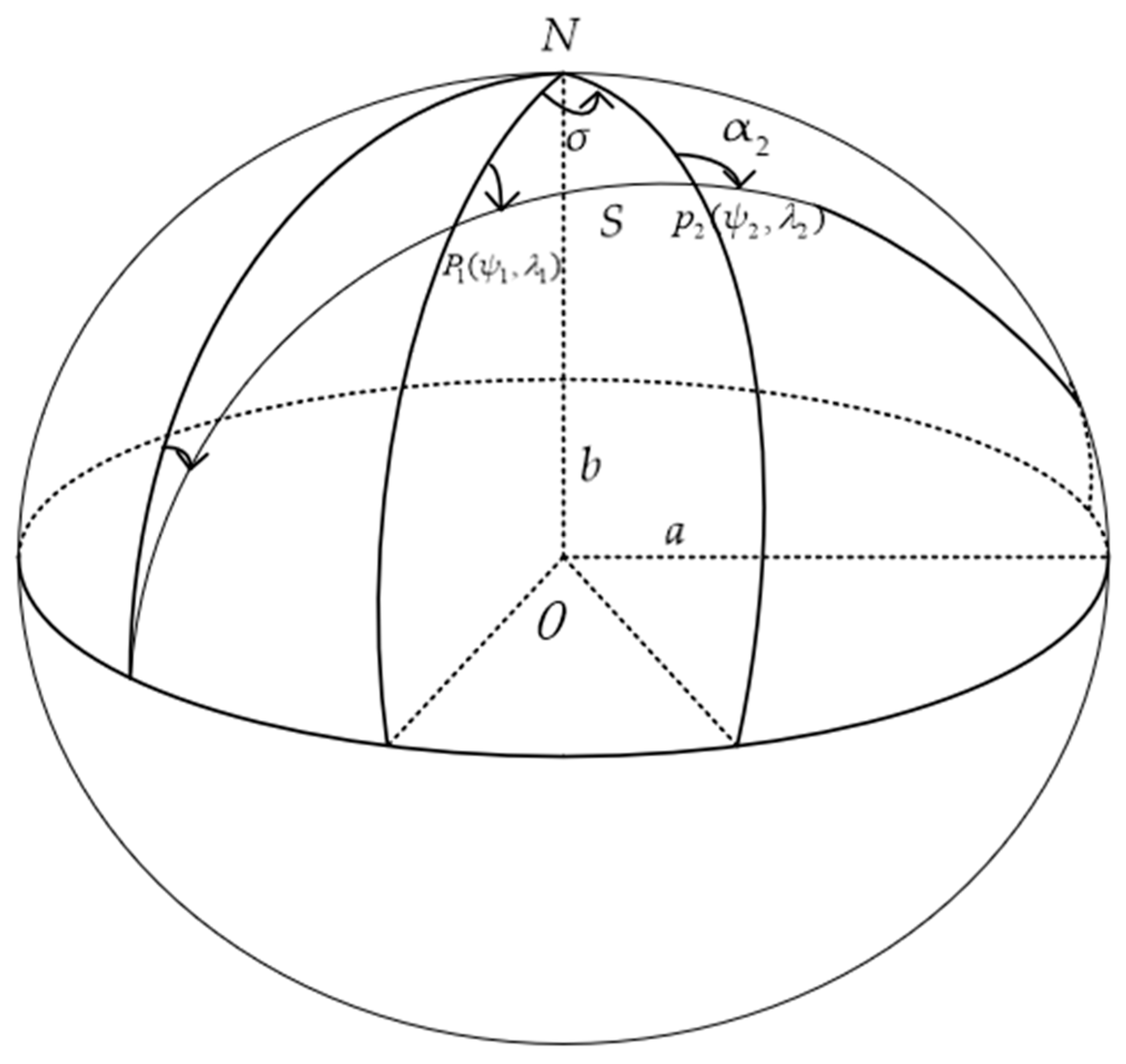
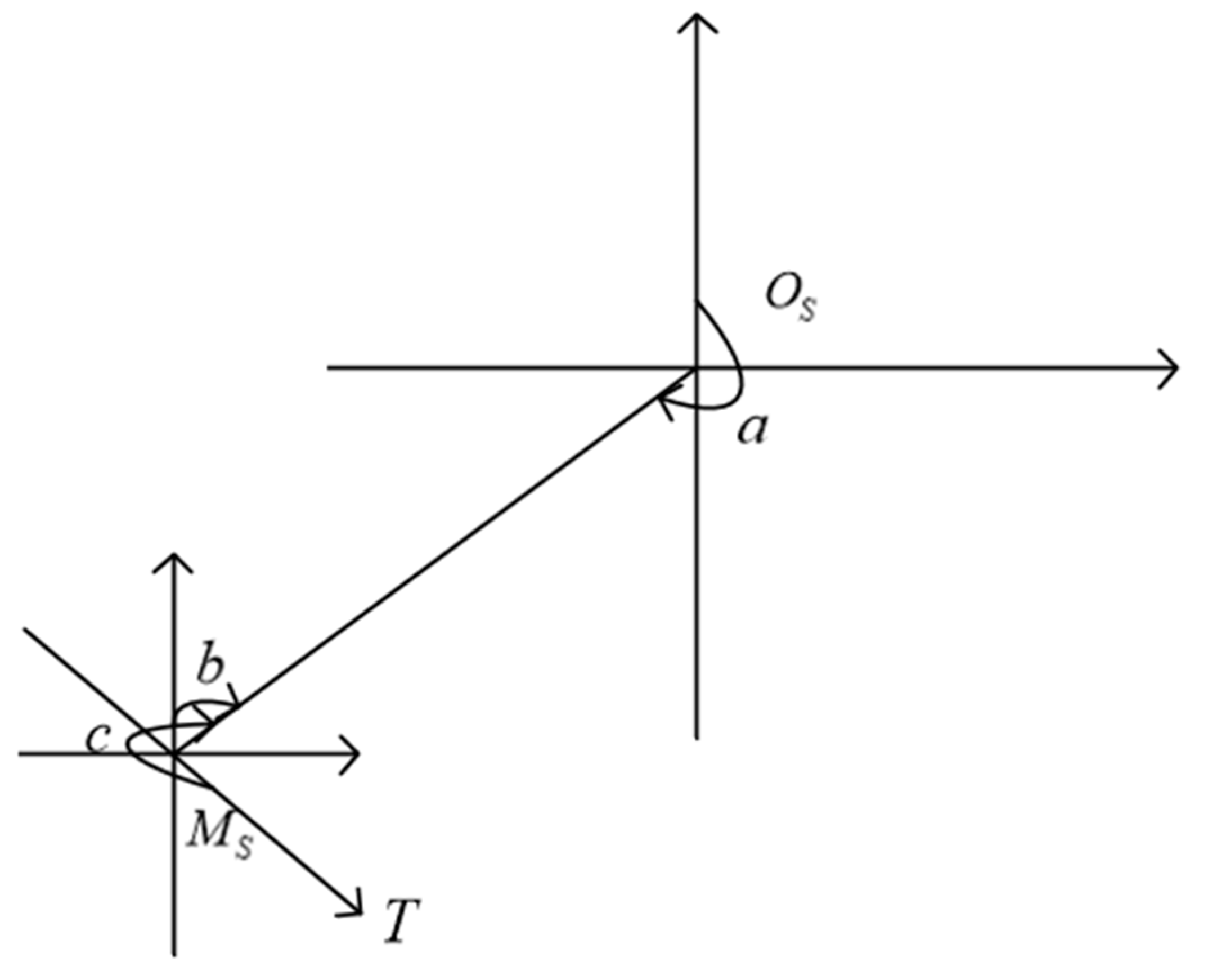



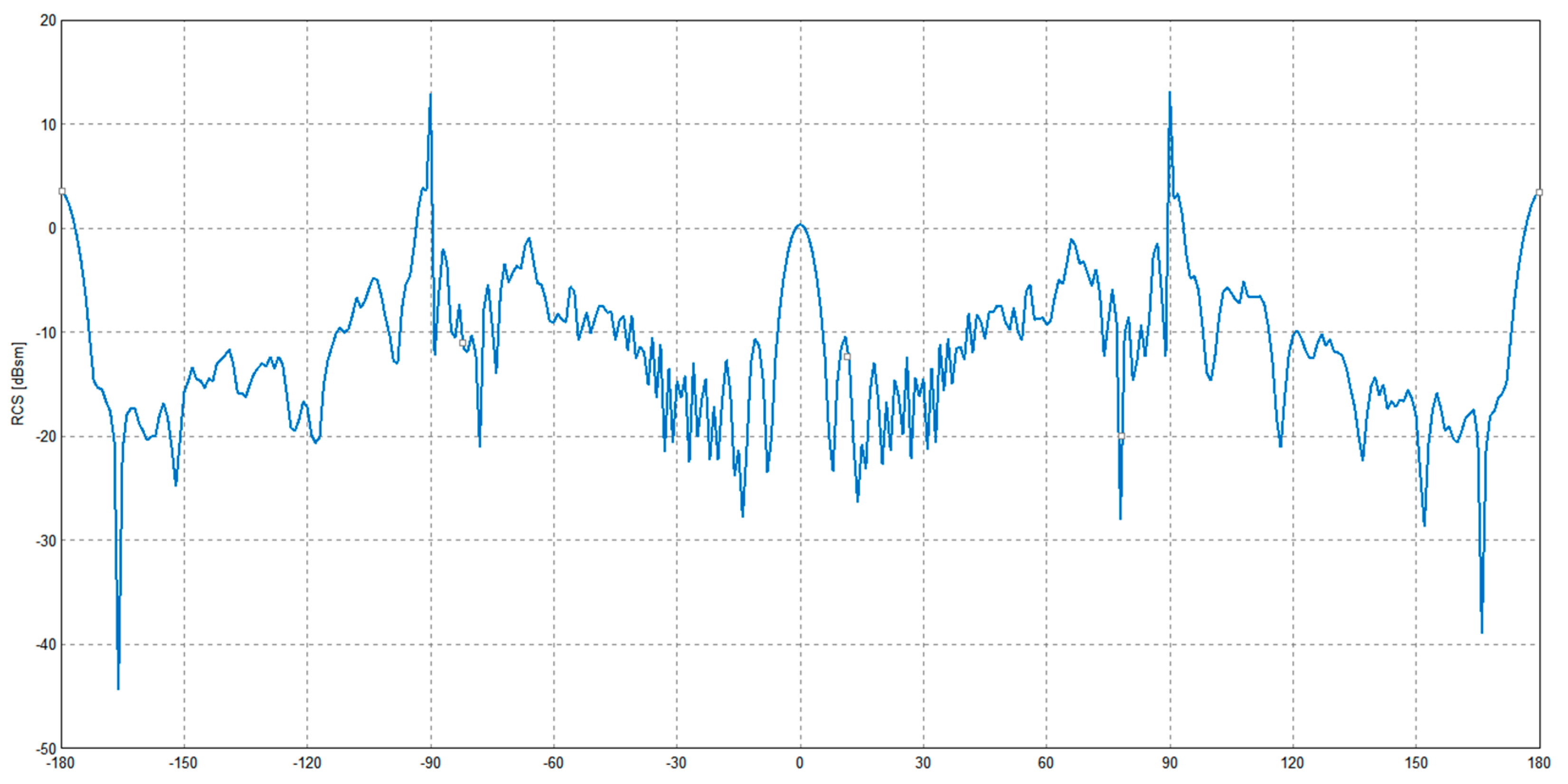
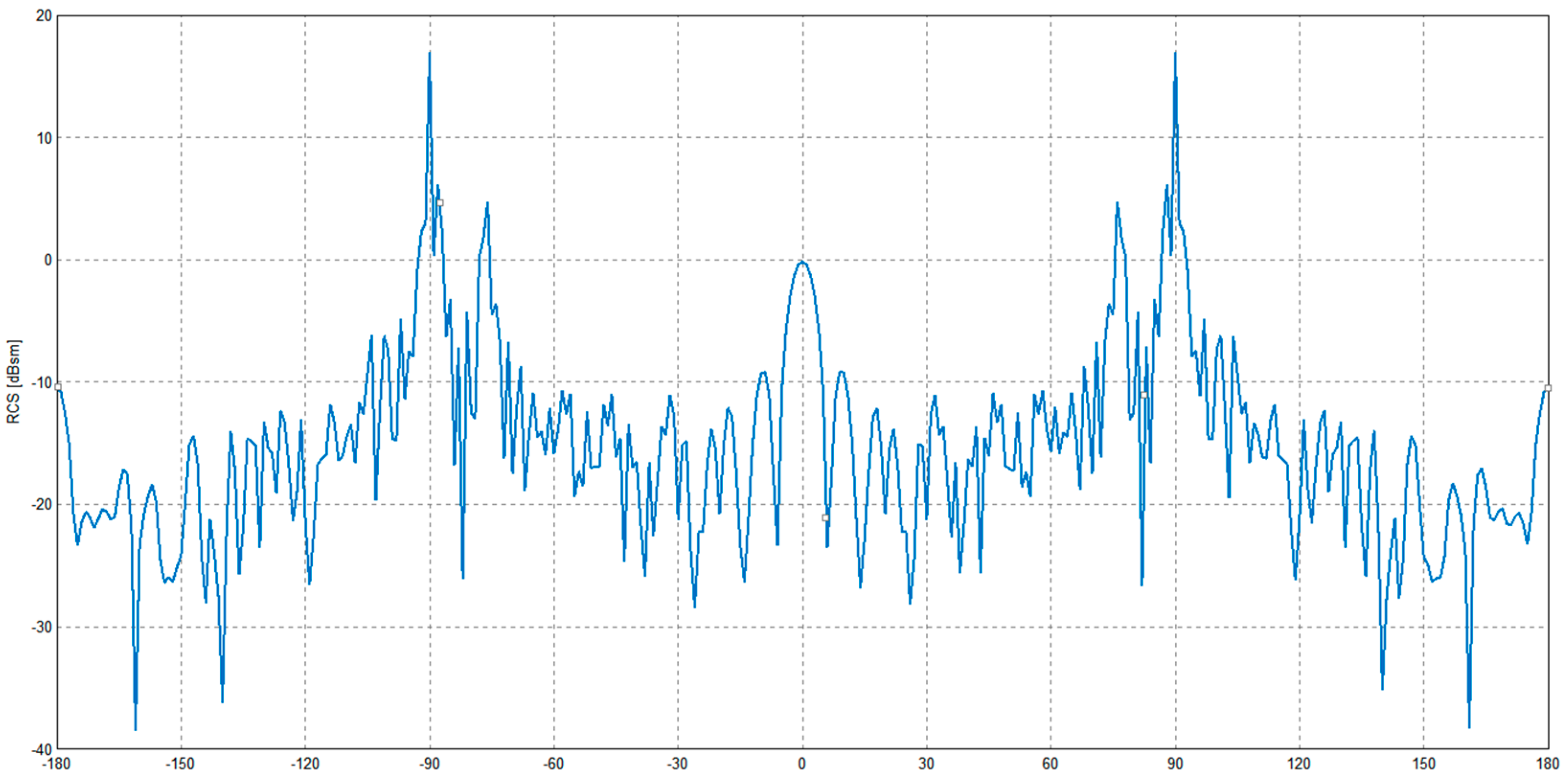
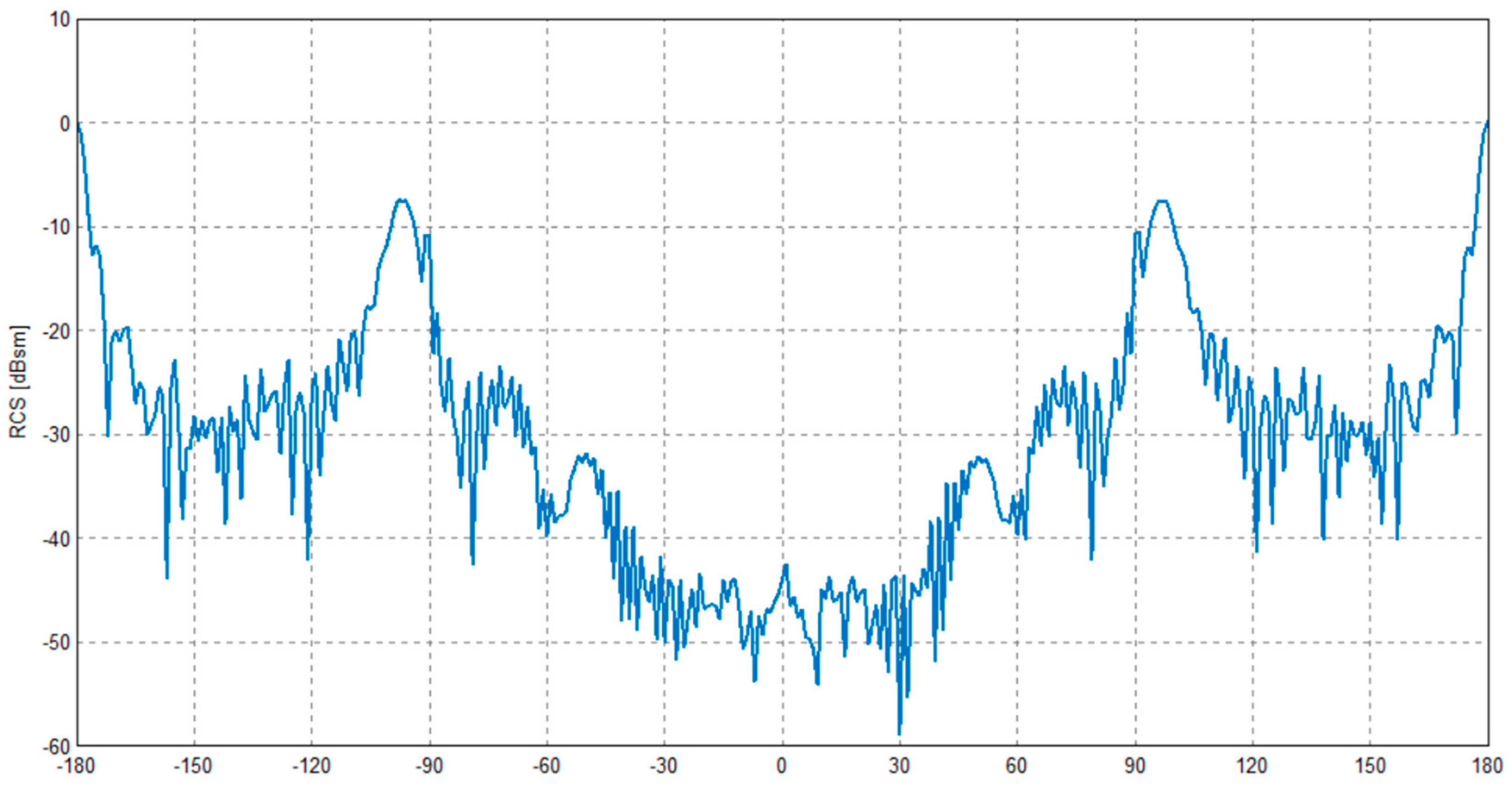
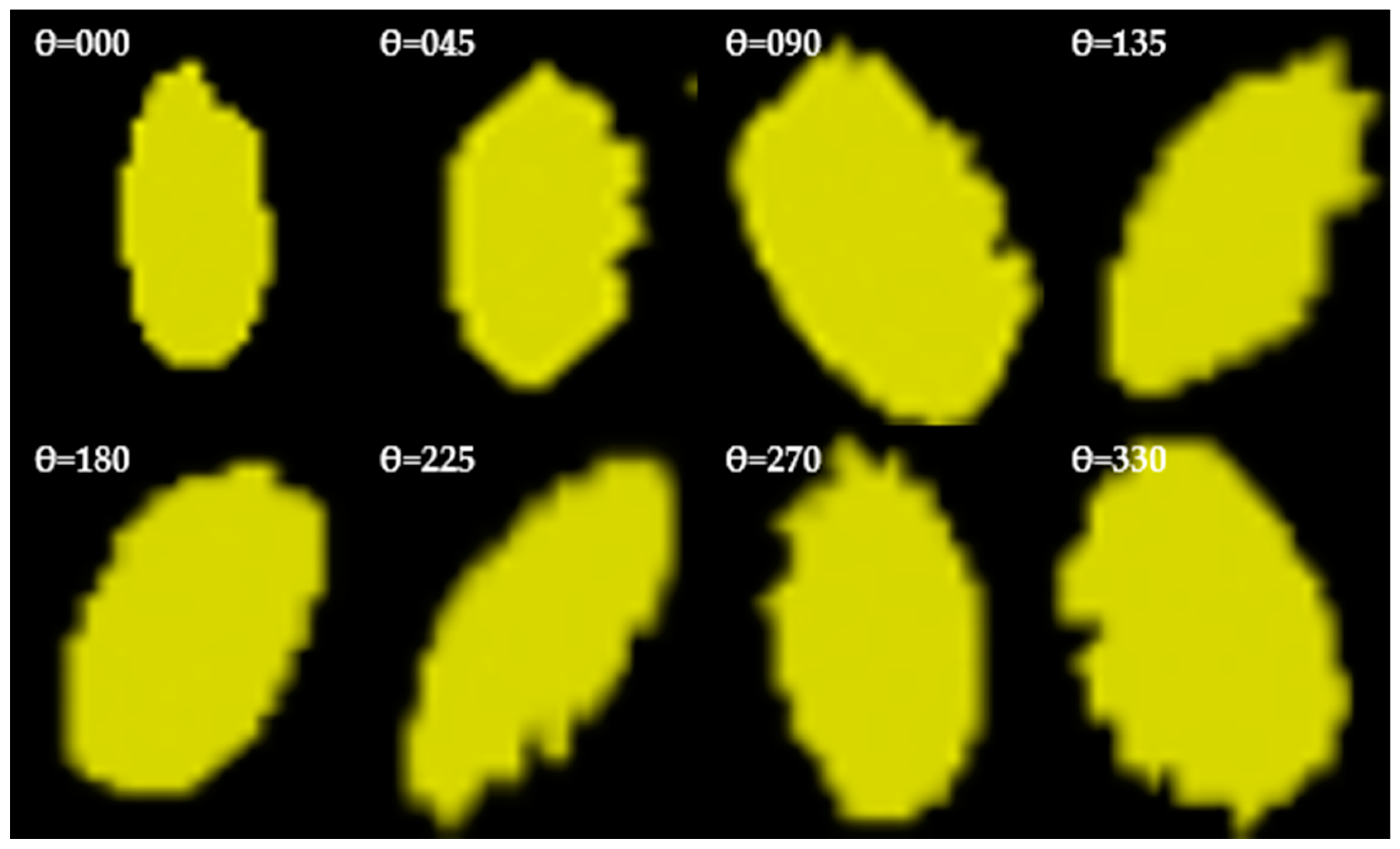
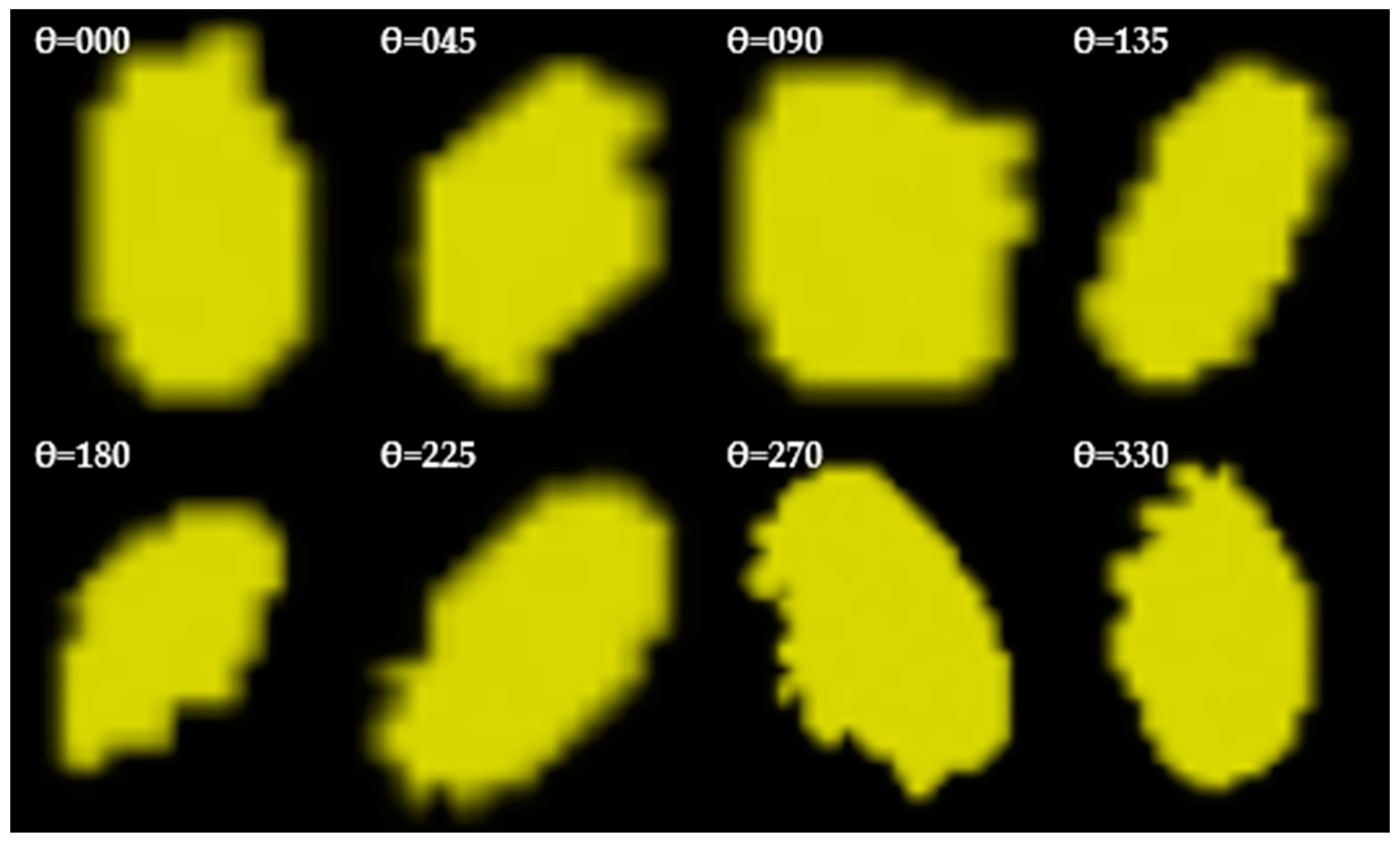
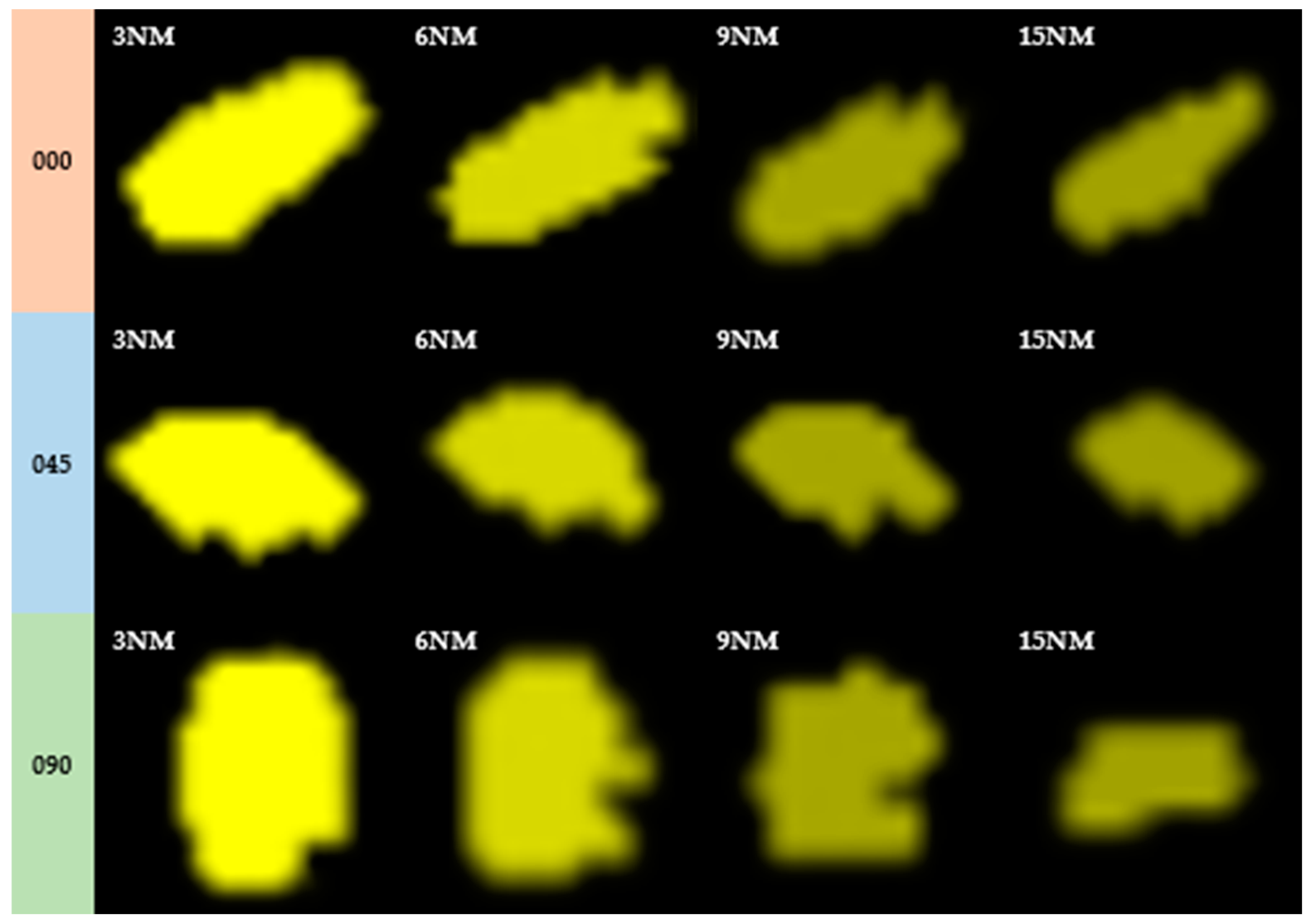
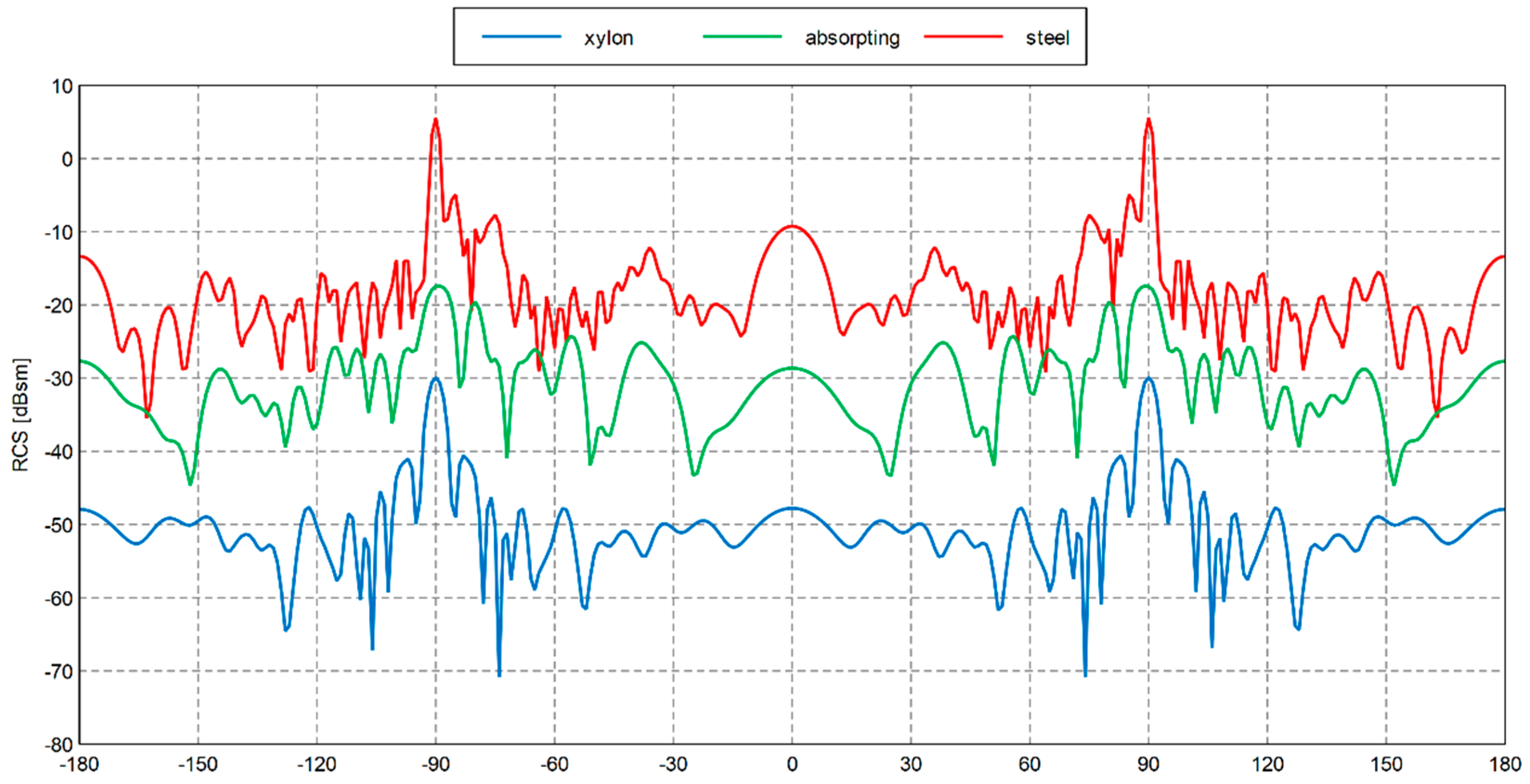
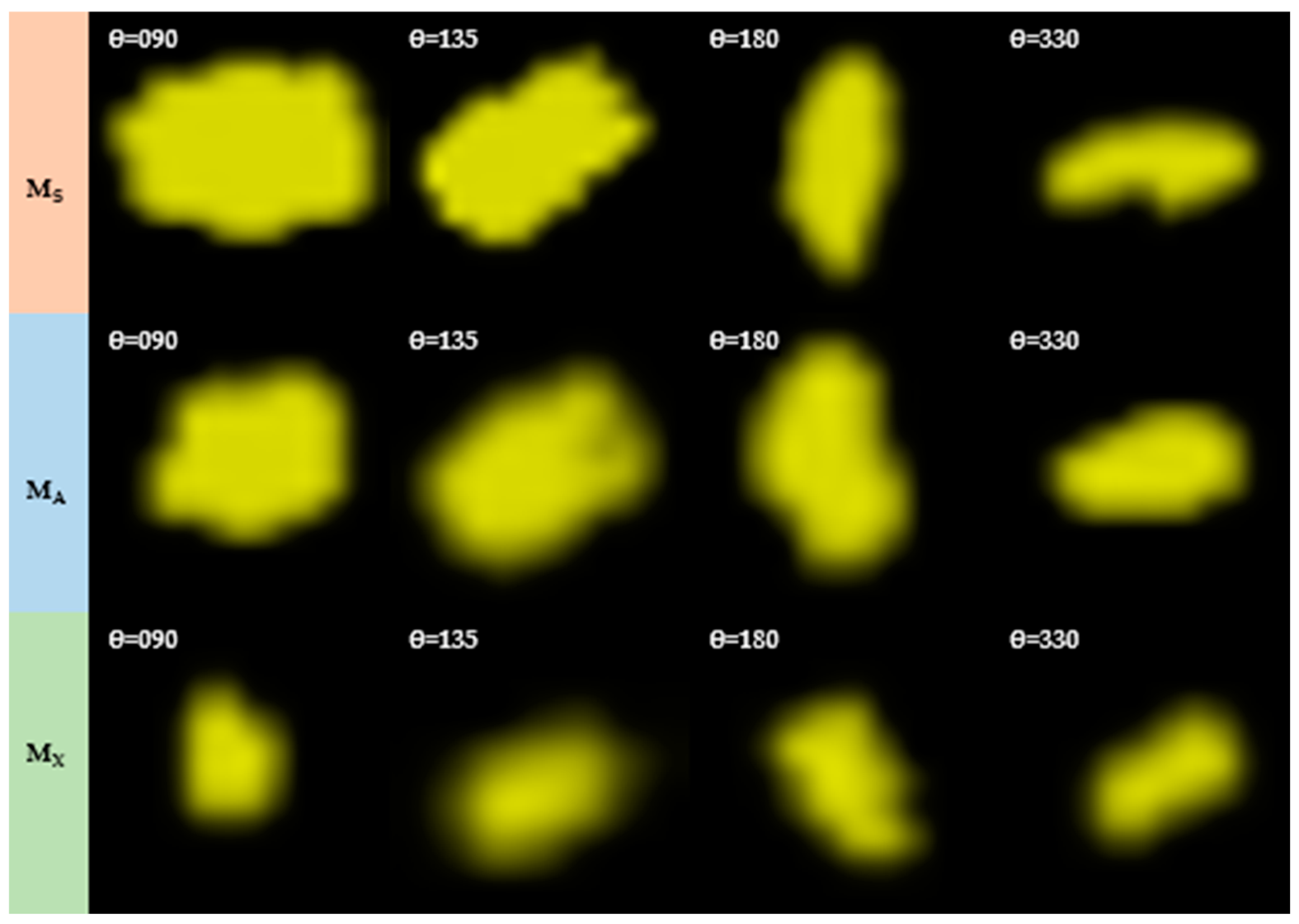
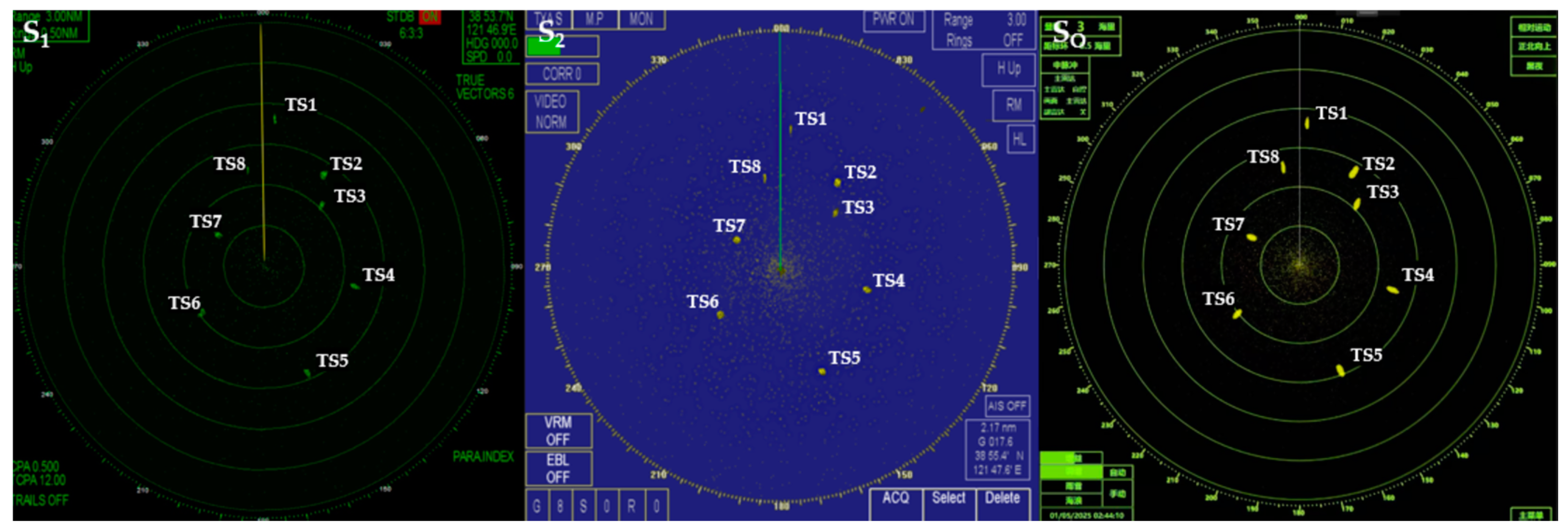
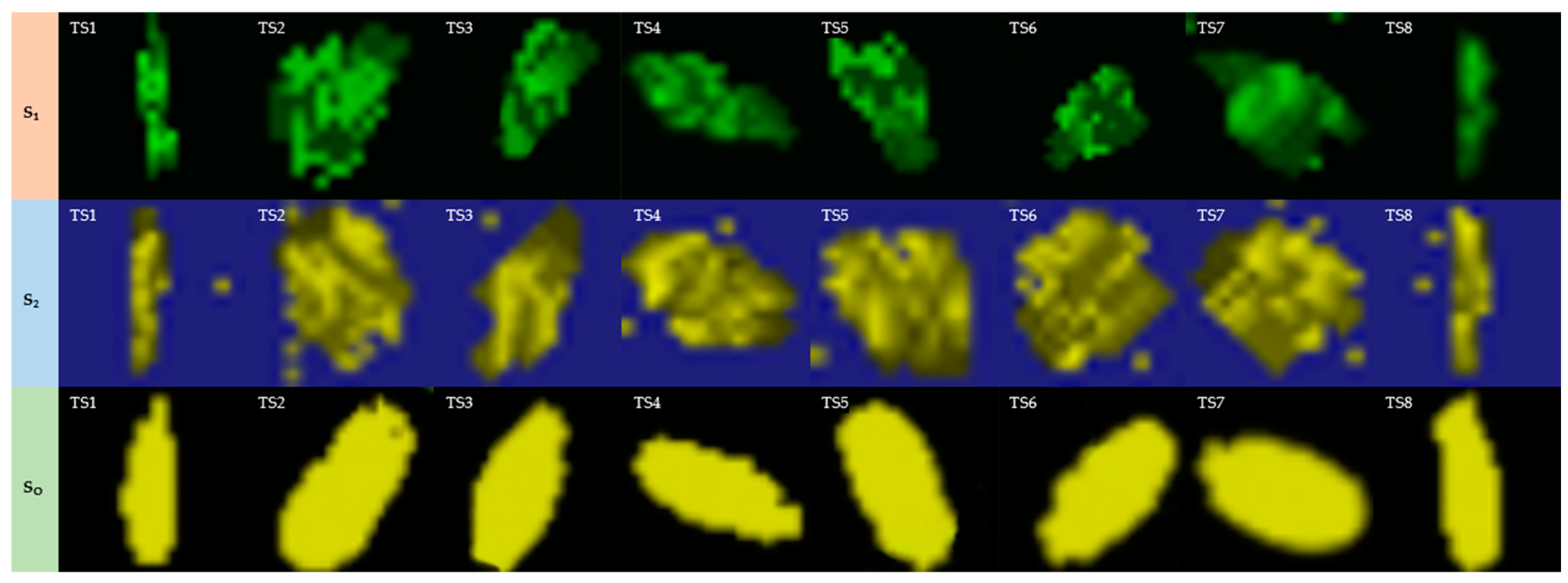
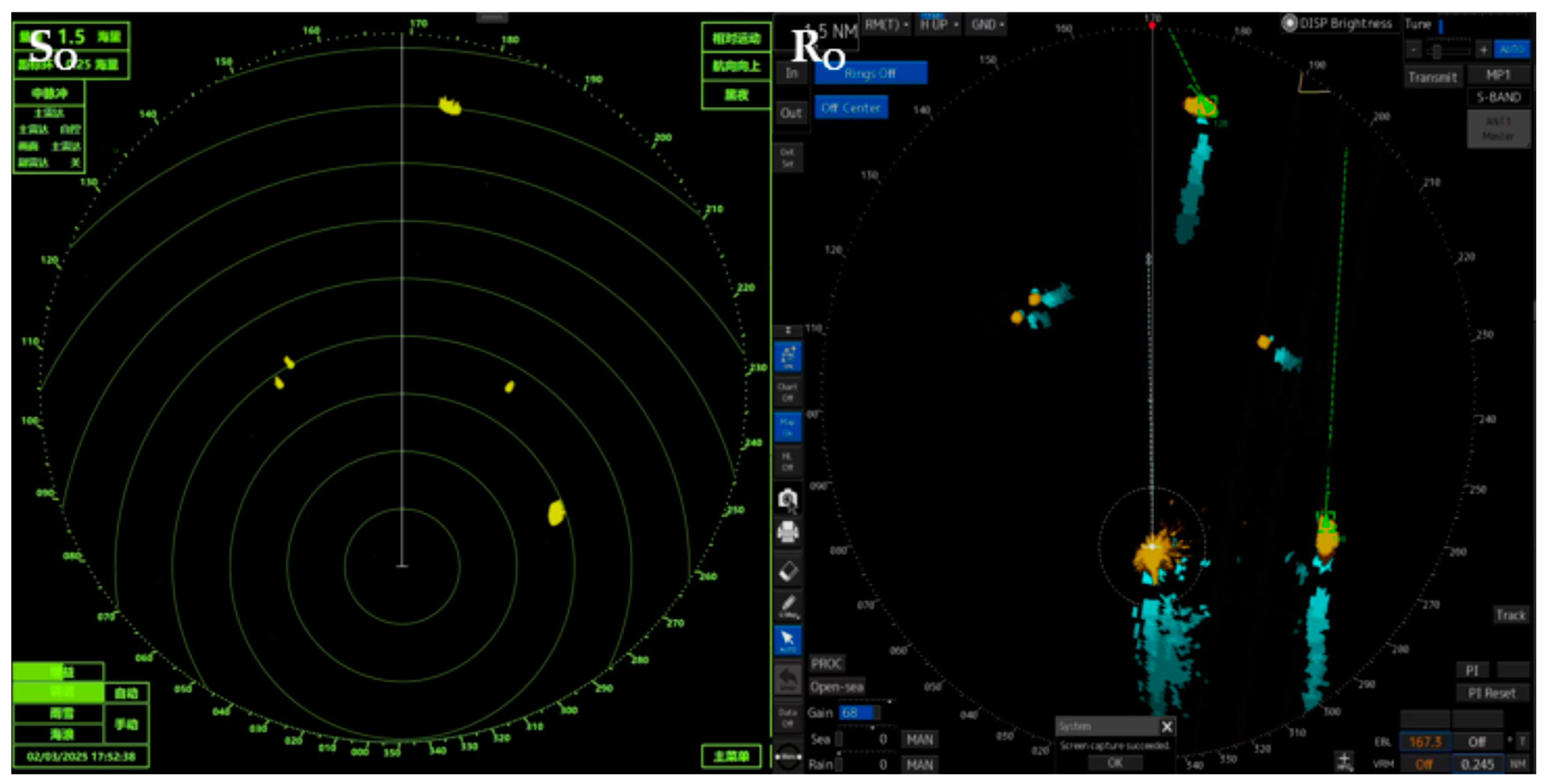
| Ship Type | Length | Width | Height | Draft | Mesh Count | Mesh Size |
|---|---|---|---|---|---|---|
| Bulk Carrier | 165 | 28 | 18 | 12.5 | 29,860 | 1 |
| Container | 225 | 38 | 20.8 | 14 | 37,580 | 1 |
| Fishing-boat | 15 | 4 | 6 | 2.4 | 6820 | 1 |
| Name | Value |
|---|---|
| Operating Frequency | 9 GHz |
| Antenna Height | 15.0 m |
| Wavelength | 0.033 m |
| Antenna Rotation Speed | 2.00 r/s |
| Scanning Angle | 360° |
| Antenna Type | Planar Array Antenna |
| Gain | 40 dB |
| Maximum Power Output | 4 KW |
| Maximum Detection Range | 96 Nm |
| ID | Bearing | Distance | Heading | Incident Angle |
|---|---|---|---|---|
| 1 | 60° | 3/6/9/15 | 240° | 000 |
| 2 | 135° | 3/6/9/15 | 270° | 045 |
| 3 | 90° | 3/6/9/15 | 180° | 090 |
| Material | Relative Permittivity | Relative Permeability | Conductivity | Density |
|---|---|---|---|---|
| Steel | 1 | 1000 | 5.8 × 107 S/m | 7.8 g/cm3 |
| Absorbing | 2.5 | 1 | 10 S/m | 2.0 g/cm3 |
| Xylon | 3 | 1 | 10−4 S/m | 1.2 g/cm3 |
| Target ID | Bearing | Distance | Heading | Speed |
|---|---|---|---|---|
| TS1 | 3° | 1.8 Nm | 357° | 5 knots |
| TS2 | 30° | 1.35 Nm | 214° | 12 knots |
| TS3 | 43° | 1.05 Nm | 194° | 2 knots |
| TS4 | 105° | 1.20 Nm | 300° | 4 knots |
| TS5 | 159° | 1.42 Nm | 329° | 7 knots |
| TS6 | 232° | 1.00 Nm | 35° | 7 knots |
| TS7 | 299° | 0.70 Nm | 287° | 9 knots |
| TS8 | 350° | 1.25 Nm | 175° | 5 knots |
| Non-English Terms | Definition |
|---|---|
| 量程 | Range |
| 距标环 | Range ring |
| 中脉冲 | Medium pulse |
| 增益 | Gain |
| 调谐 | Tune |
| 雨雪 | Rain |
| 海浪 | Sea |
| 相对运动 | Relative Motion |
| 正北向上 | North Up |
Disclaimer/Publisher’s Note: The statements, opinions and data contained in all publications are solely those of the individual author(s) and contributor(s) and not of MDPI and/or the editor(s). MDPI and/or the editor(s) disclaim responsibility for any injury to people or property resulting from any ideas, methods, instructions or products referred to in the content. |
© 2025 by the authors. Licensee MDPI, Basel, Switzerland. This article is an open access article distributed under the terms and conditions of the Creative Commons Attribution (CC BY) license (https://creativecommons.org/licenses/by/4.0/).
Share and Cite
Li, C.; Yang, X.; Ren, H.; Li, S.; Feng, X. Marine Radar Target Ship Echo Generation Algorithm and Simulation Based on Radar Cross-Section. J. Mar. Sci. Eng. 2025, 13, 348. https://doi.org/10.3390/jmse13020348
Li C, Yang X, Ren H, Li S, Feng X. Marine Radar Target Ship Echo Generation Algorithm and Simulation Based on Radar Cross-Section. Journal of Marine Science and Engineering. 2025; 13(2):348. https://doi.org/10.3390/jmse13020348
Chicago/Turabian StyleLi, Chang, Xiao Yang, Hongxiang Ren, Shihao Li, and Xiaoyu Feng. 2025. "Marine Radar Target Ship Echo Generation Algorithm and Simulation Based on Radar Cross-Section" Journal of Marine Science and Engineering 13, no. 2: 348. https://doi.org/10.3390/jmse13020348
APA StyleLi, C., Yang, X., Ren, H., Li, S., & Feng, X. (2025). Marine Radar Target Ship Echo Generation Algorithm and Simulation Based on Radar Cross-Section. Journal of Marine Science and Engineering, 13(2), 348. https://doi.org/10.3390/jmse13020348





